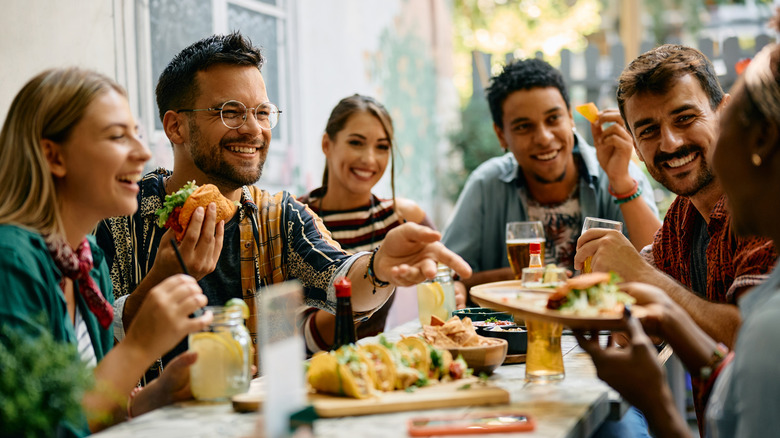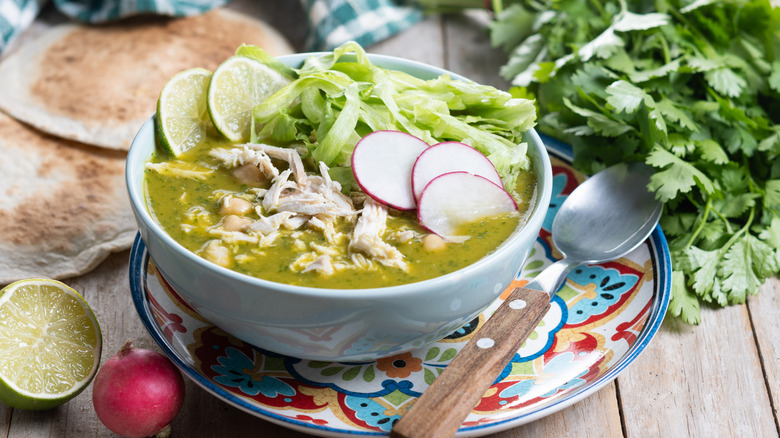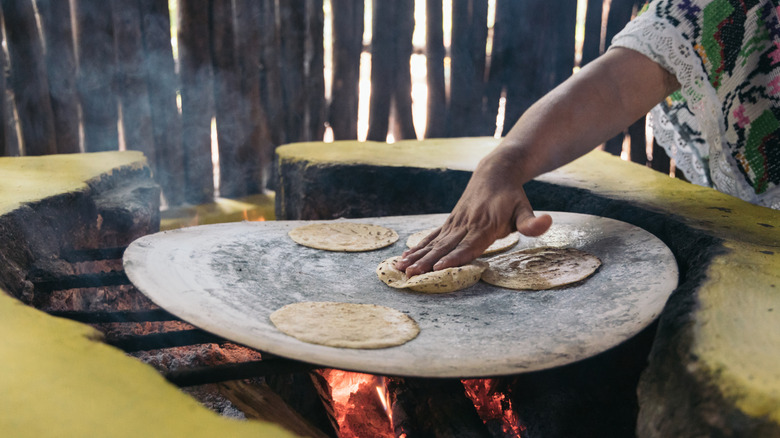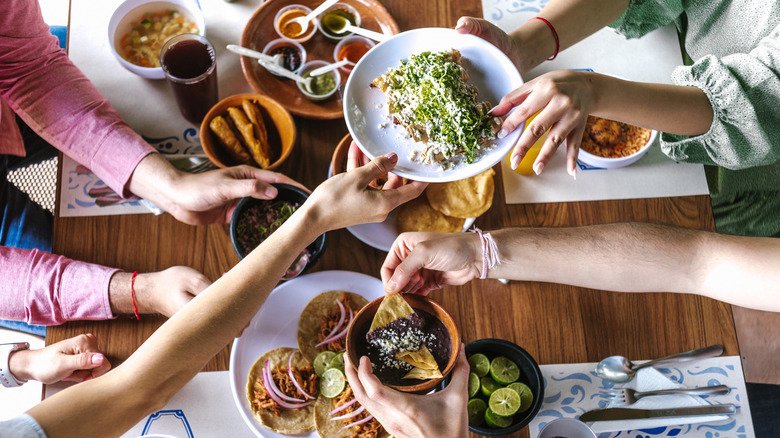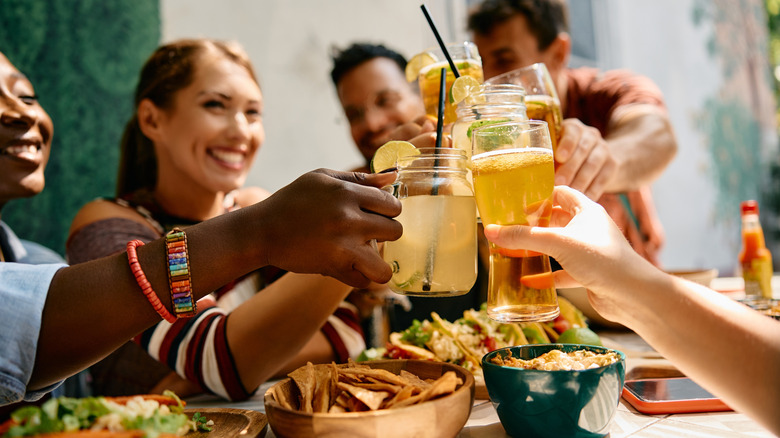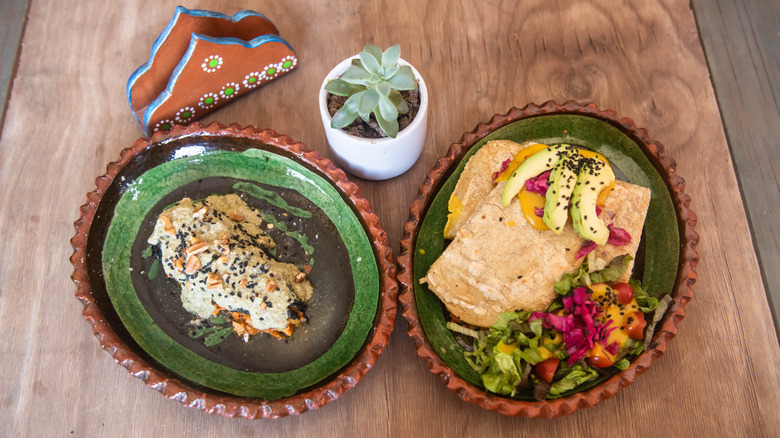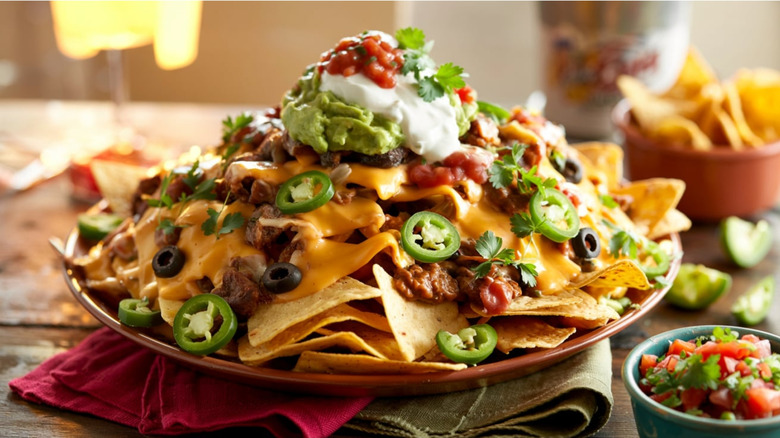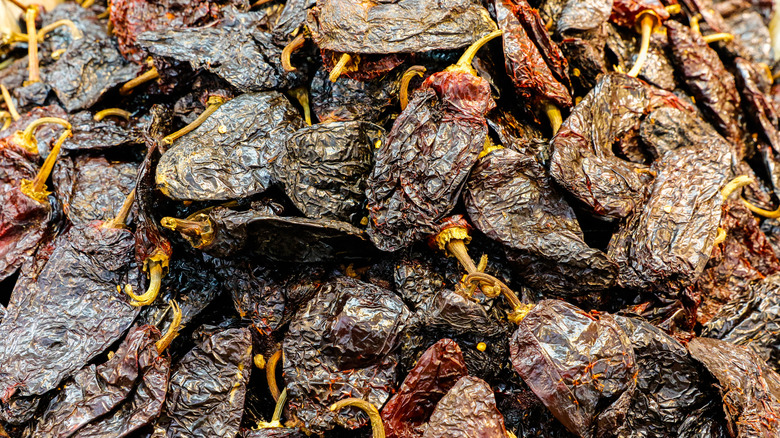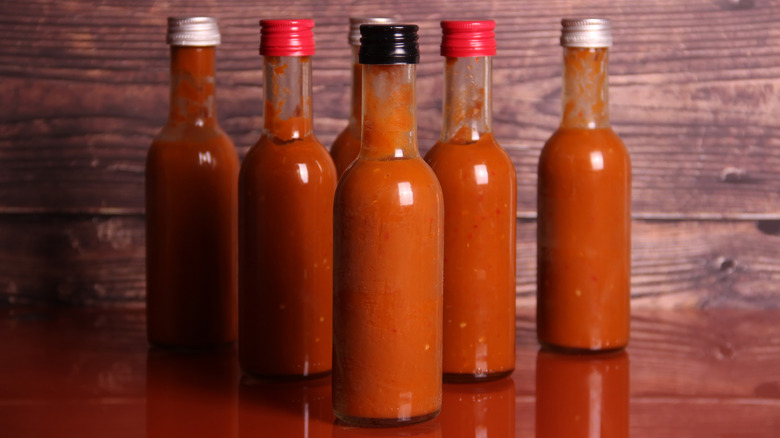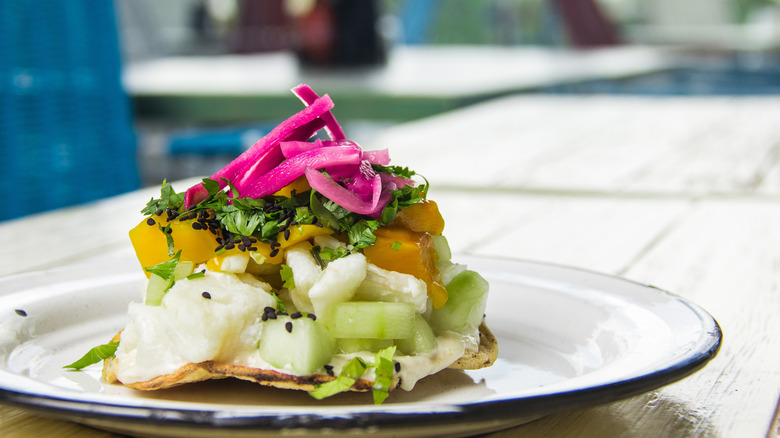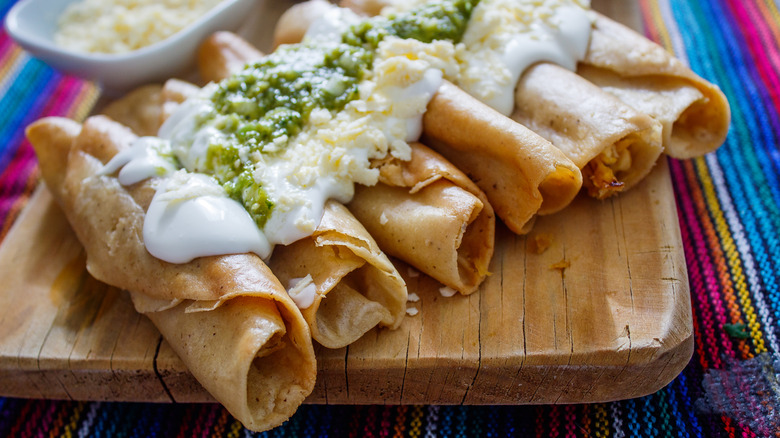11 Mistakes Everyone Makes Eating At A Mexican Restaurant, According To Chefs
Heading out to dinner at a Mexican restaurant can be a real treat. Under the right conditions, you can expect a night of excellent food. However, there are some mistakes everyone makes eating at Mexican restaurants — and these can leave you feeling unsatisfied with your meal and wishing you'd gone elsewhere.
Whether you always stick with the dishes you're familiar with and miss out on more inventive options or you pick the wrong spot, there are a range of factors that can make your meal not as good as it could be. I'm a big fan of Mexican food, but I wanted to get opinions from real experts. So, I interviewed three chefs from Mexican restaurants and a food blogger who specializes in Mexican cuisine. They were able to give me more insight into those common errors people make when ordering.
Sometimes getting a better experience is about branching out, choosing some regional specialties, and trying dishes you may have never heard of before. Other times, it's looking out for those indicators of a quality restaurant before you even head through the door. Here are 11 common missteps people make at Mexican restaurants. Knowing what to avoid will help you make better decisions and come away having enjoyed a brilliant meal.
1. Sticking with familiar dishes
What do you usually order when you eat at a Mexican restaurant? If your answer is familiar dishes like tacos, burritos, and quesadillas, you might be making a mistake. There are so many more options out there that you're missing out on.
Executive chef Gerardo Duarte of Mayahuel in Astoria, New York laments that diners often make the mistake of sticking to what they're familiar with. "When we opened Mayahuel, we made the bold choice not to serve nachos or burritos," he tells us. "It was risky, some guests even walked out, but it was important for us to show that Mexican cuisine is so much more than Tex-Mex." He advises not to be afraid of exploring beyond the familiar, as Mexican food is multilayered with many regional variations.
"People often stick to tacos or burritos and miss out on the dishes that really showcase the depth of Mexican cuisine — things like mole, pozole, or regional specialties," says chef Thierry Amezcua of Papatzul in New York's SoHo district. The restaurant serves dishes like octopus tostadas and aguachile negro, which Amezcua believes represent Mexico just as much as tacos do.
Yvette Marquez-Sharpnack of the blog Muy Bueno agrees. "I wish people would explore dishes like birria or pozole," she remarks. "They are soulful and show off the authentic flavors of Mexico." The untold truth of birria is that is has taken off on social media, with hundreds of thousands of posts shared on the dish in recent years.
2. Eating at spots that don't make fresh tortillas
Once you've eaten fresh tortillas, you'll realize that the store-bought versions just don't compare. So, if you're eating at Mexican restaurants that don't make tortillas in house, you're making a mistake. It's also a good gauge of whether or not an establishment is worth eating at. You can usually tell a Mexican restaurant is good when its tortillas are crafted in house.
It's not an easy process, especially when corn tortillas are made totally from scratch rather than using masa harina. So, it makes sense that not all chefs can commit to this, but it's a sign that a restaurant is going above and beyond, meaning the rest of the food is likely to be made with care and skill.
"We nixtamalize our corn in house before hand-pressing every tortilla we serve," explains Gerardo Duarte. He even sources the corn used from Mexico. "It's a labor-intensive and costly process, but it's also what makes our food true to its Mexican roots," he says.
Chef Alex Tellez from Sor Ynez in Philadelphia also makes tortillas, noting that many people don't know how labor-intensive Mexican food actually is. "It's a three-day process for our tortillas to make it to a guest's table at Sor Ynez," he tells us. On day one, the corn is nixtamalized and soaked overnight. On the second day, it's ground and made into masa. On the third day, chefs make fresh tortillas for service. "We'll repeat the process as many times as required to keep our masa and tortillas fresh," Tellez explains.
3. Not ordering dishes family style
When you head to a Mexican restaurant, chef Alex Tellez recommends ordering dishes family style to share between everyone at the table. It's an excellent way to explore a new or unfamiliar menu. We know that sharing food can be an issue for some, but it means you get to sample more delicious dishes. So, if you're stuck between a couple of options on the menu, it's the perfect solution.
In some restaurants, you can even order a combination of starters and sides and ask them to come out all at the same time, or when each dish is ready, rather than having the starters first and then the mains. This can give you an even wider range of options to select from, but ask your server first rather than assuming that all eateries are happy to serve dishes this way.
What's great about ordering several dishes to share is that it's a good way to try out dishes you've never eaten before. If you're concerned about ordering dishes you haven't tried or haven't even heard of, you could pick some more familiar classics to fall back on, plus a couple of options that are new to you. This way, you've still got something you know you like, but you'll probably love the unfamiliar dishes, as well.
4. Not ordering a drink with dinner
We're not saying that everyone at the table has to drink, but if you're in the mood for alcohol and you're not the designated driver, sticking to water with your meal can be a mistake. "I do think people miss out when they don't order a drink," says food blogger and recipe developer Yvette Marquez-Sharpnack. This is because Mexican food and certain drinks complement each other. "A smoky mezcal with mole, a crisp beer with tacos al pastor, or an agua fresca with enchiladas can completely elevate the meal," she adds.
Ordering the wrong drink with dinner can also be an error. Mayahuel's executive chef Gerardo Duarte says that so many customers default to margaritas, missing out on the restaurant's great selection of tequila's less known cousin mezcal, tequila, and lesser-known Mexican spirits like sotol. "One of our sotol cocktails, with its earthy flavor, pairs wonderfully with our moles," Duarte tells us. He says diners can miss a part of the experience by skipping those pairings. If you'd like to try a more unexpected drink next time you hit up a Mexican restaurant but you're not sure where to start, ask the waiter. They should be able to recommend a drink that will pair nicely with your meal.
5. Assuming dishes can't be adapted to meet dietary requirements
When you head to a Mexican restaurant, you might expect lots of meat, cheese, and sour cream, and not much for vegans, vegetarians, and folks with other dietary restrictions. But failing to ask about your options is a mistake. Rather than just ordering chips and salsa while the rest of your group feasts, ask if anything can be adapted, if it's not already clear on the menu. You might be surprised.
According to Alex Tellez, customers commonly ask about substitutions for dietary restrictions. And, at Sor Ynez, they're able to accommodate most. "We have a separate fryer for our chips to keep them gluten-free and vegan, and we're happy to handle any substitutions so people can enjoy our food how they want to," he tells us. "Many of our dishes are naturally vegan," he adds.
Gluten-free diets are often easier to accommodate than you might think, as well. A classic recipe for corn tortillas is gluten-free, as are tortilla chips. So, you might not be able to eat anything that comes in a soft flour tortilla, but a lot of the other dishes on the menu are likely to be suitable.
6. Making assumptions about what is and isn't authentic
People often make assumptions about what is and isn't authentic at a Mexican restaurant. Some folks think they'll be able to find Tex-Mex classics on the menu and don't recognize lesser-known authentic dishes. Others believe that certain dishes or ingredients aren't authentic when they're really ignoring the variety of Mexican food and how real people serve it in their homes.
Chef at Papatzul, Thierry Amezcua, says that people often expect big plates of nachos covered in melted cheese to be on the menu. "It's delicious bar food," he says, "but it's not what you'd find in a traditional Mexican kitchen." You might have seen it on other menus, but it doesn't mean it's a food that people regularly eat in Mexico.
"Mexico's culinary traditions are incredibly diverse," explains chef Gerardo Duarte. "For example, at Mayahuel, we highlight seafood, like our Pulpo Encacahuatado: grilled octopus with peanut mole and cauliflower purée, which has become a guest favorite." So, just because you see something you don't recognize on the menu, it doesn't mean it's not a true recipe from Mexico, it just means you haven't heard of it.
Plus, there are some ingredients that people look down on but that might be common amongst Mexican communities. "Some people think yellow cheese automatically makes a meal 'not authentic,' but that's not true," says Muy Bueno blogger Yvette Marquez-Sharpnack. "In New Mexico and parts of Texas, yellow cheese is part of the tradition, and I grew up with it in El Paso."
7. Asking to leave out chiles
Not everybody loves spicy food, but if you ask for the chiles to be removed from a dish, you might be ruining its balance. Chiles don't just make something hot, they also bring nuanced flavor, so when they're omitted, the resulting meal might seem lacking.
Yvette Marquez-Sharpnack explains "they bring flavor, smokiness, and depth" to dishes, adding that "if you take them out, the dish just loses its character." And Chef Thierry Amezcua backs this up. "Sometimes guests want to take the heat or spices out of our aguachile," he notes. "Our aguachile negro is made with roasted habanera for heat but the lime balances it out." According to Amezcua, spice in authentic Mexican cooking is about balancing a dish, as well as adding depth and flavor.
We get that some dishes are just too spicy for some people, and that's OK. But rather than trying to tone down a dish in which chile peppers are an integral ingredient, you could just opt for something that's naturally milder. Not all Mexican food is hugely spicy and some dishes aren't hot at all. If you're unsure, just ask your server for a recommendation.
8. Reaching for the bottled hot sauce
When you go out to eat at a Mexican restaurant, you might be tempted to cover everything in bottled hot sauce. Maybe it's because you're a hot sauce fiend or you wanted your dish spicier, or perhaps you just think it's what you're meant to do, but it can be a mistake.
There are some foods that pair nicely with hot sauce, but you shouldn't assume that everything on the menu needs to be doused in the stuff. It can actually have the opposite effect than what you want from a condiment and end up detracting from the dish.
Some chefs actively advise against using bottled hot sauces. Gerardo Duarte comments that the dishes at his restaurant Mayahuel are meant to pair with the salsas that are made in house. "For instance, our salsa macha enhances seafood dishes beautifully, while the chile de árbol salsa is perfect for tacos," he remarks. However, "a bottled sauce just flattens these flavors."
So, before you reach for that bottle of Cholula, think about whether the dish really needs it. Many high-end Mexican restaurants don't have hot sauce on the tables for this very reason. The food is already perfectly balanced or it's meant to pair with a particular salsa, so a basic bottle of hot sauce isn't doing it any favors.
9. Ordering the same dish on every visit
We know what it's like to have a favorite dish at a particular restaurant. That one meal that always tempts you. However, when you always order the same thing, no matter how good it is, you're missing out on other amazing options. And, if you love that one thing so much, there are bound to be other dishes on the menu that you'd like just as much or even more.
Alex Tellez recommends trying new things on every visit. Sor Ynez, where he is a chef, actually has a seasonal menu, so dishes change, anyway. "If you approach the menu with curiosity and trust, the whole experience will be even more rewarding," he says. There's so much great food throughout the country that it's a shame to only ever stick to one thing.
"Experienced guests understand the diversity of the cuisine," Gerardo Duarte notes. Since he's from the Northern coast of Mexico, Mayahuel's menu reflects those regional influences. "Dishes like pulpo encacahuatado or our tuna tartare with avocado purée, mango, salsa macha, and crispy sweet potato chicharrón highlight that," explains Duarte. Even if you're stuck on a favorite, branching out to try new dishes can really pay off.
10. Not asking what the house specialty is
"The smart move is to ask the waiter what the specialty of the house is," Yvette Marquez-Sharpnack says — and this is great advice. It's all too easy to just pick on a whim or go with something you recognize the name of. But if a restaurant has a particular specialty, it's worth seeking it out.
"Every restaurant has that one dish ... [it is] extra proud of, and that's usually where you'll taste ... [its] best, most authentic flavors," says Marquez-Sharpnack. "Skip the filler items and go for ... [the] best." In some restaurants, this might be a dish from a particular region where the head chef comes from, like the North coast specials at Mayahuel. At other spots, it may be that extra attention is put into certain dishes, like house-made corn tortillas or a slow-cooked stew.
For instance, chef Thierry Amezcua always recommends guests try the chicken mole at Papatzul. "Mole is one of the crown jewels of Mexican cooking, and it deserves more attention than it gets," he says. Done right, it's complicated and contains way more ingredients than you're likely to bother gathering up at home, so it makes sense to enjoy it at a restaurant.
11. Smothering everything in sour cream
Both Thierry Amezcua and Yvette Marquez-Sharpnack mention a cardinal sin that you should try to avoid at Mexican restaurants: covering everything in freshly made sour cream. We get it, sour cream is delicious and we've all been in a position where we've dolloped it all over our food. But, as Amezcua says, "that's not the point of Mexican cooking."
When you drown your dish in sour cream, you're wrecking the balance of flavors. A small amount of crema might be great on certain items, but tossing it indiscriminately over everything is going to make a good meal worse, not better. You'll lose some of the layers of flavors that have gone into a dish, especially if it's on the more delicate end of the spectrum.
While some dishes are heavy with huge lists of spices, others are fresher and lighter, and sour cream can quickly overwhelm them. But even the more robust dishes just don't need it. Nor should they be covered in piles of cheese. Trust the chef and stick with whatever sour cream, if any, comes with the dish. There's no need for extra if the food is good. It should stand up on its own. If it's too spicy without, try ordering something milder. And if you simply don't like the food when it's not doused in sour cream, try eating somewhere better.
